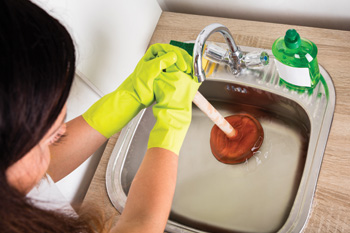
Nothing puts a damper on a great dinner like a clogged drain and backed-up kitchen sink afterward. And nothing ruins a morning shower like standing ankle-deep in soapy water. But with a few simple tools and expert tips from the Seider Heating, Plumbing & Electrical team, you can wash clogs (and worries) down the drain.
A Few Good Tools
Invest in these inexpensive, must-haves for homeowners to unclog toilets and drains:
- Plunger—a stout handle and larger rubber bell delivers the most force
- Snake—look for a 3/8- or 1/4-inch model that’s approximately 20 feet long
- Bucket or pail—any type works, as long as it fits under your drain
- Rubber gloves
- Flashlight
- Adjustable wrench
6 Steps for Opening a Clogged Drain
Some drain issues require plumbing expertise, but others can be cleared up with these steps:
- Clear out standing water. Remove standing water ASAP, since it breeds mold, bacteria, and insects in no time. Removing it also makes room for the added water you’ll need to flush the drain later.
- Remove visible blockages and check garbage disposal. From unwanted hair to scraps of leftover food, it’s important to don your rubber gloves and get waste out of the way. (A low hum from your garbage disposal likely means it’s clogged. Shut it off, unplug the unit, and free the clog by manually turning the blades.)
- Try boiling water and salt, or vinegar and baking soda. Pour one-half cup table salt down the drain, followed by boiling water. Or try a cup of baking soda and a cup of vinegar—let it bubble, wait 15 minutes, then pour boiling water down the drain. You can also try a cup of baking soda and a half-cup of salt; let it sit for several hours, then flush with boiling water. Repeat these steps if necessary, before calling in a plumber.
- Plunge it out. If the boiling water and above mixtures don’t work, try plunging. First, stuff a rag in the tub or basin overflow hole, or close the other side of a double sink with a cloth or stopper. This creates a tighter seal that delivers pressure directly to the clog. After plunging vigorously several times, flush drain with warm water.
- Clean the P-trap and snake it. The P-trap is at the curve of the drainpipe under the sink. Place a bucket or pail underneath to catch any water or debris. Loosen the slip nut on the trap arm and assembly, and gently wiggle it free. Remove any obstruction caught here and reinstall, but do not over-tighten the slip nuts—hand tighten plus a quarter turn with a wrench is secure enough.
- Snake the drain. If the clog is not visible after removing the P-trap, start snaking. Remove the P-trap to expose the pipe’s “stubout” and thread the snake’s tip into it. Tighten the setscrew and spin snake in a clockwise direction down the drain. Continue turning snake until you encounter resistance and feel the blockage release. Retract the snake, reassemble the P-trap, and rinse with plenty of warm water to flush the newly opened line.
Still Backed Up?
If these steps don’t work, you may need to schedule an appointment with a Seider plumbing professional. As Southeastern Wisconsin’s oldest and largest Carrier® dealer, we’ve also been providing comprehensive heating and air conditioning services to Greater Milwaukee area homes and businesses since 1912.
